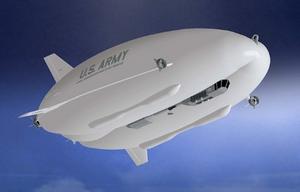BlimpsLEMV surveillance airship taking shape
The persistent-surveillance long-endurance multi-intelligence vehicle (LEMV) is designed to have an endurance when operating unmanned for 21 days at 20,000 ft. carrying a 2,500-lb. payload of sensors and communications equipment; the critical design review was completed at the end of November, final assembly is to begin in February, and first flight is planned for the end of July 2011

Artist's rendering of Northrop-Grumman's LEMV // Source: riajournal.com
Six months after contract award, elements of Northrop Grumman’s long-endurance multi-intelligence vehicle (LEMV) hybrid airship are coming together.
The persistent-surveillance LEMV is designed to have an endurance when operating unmanned for 21 days at 20,000 ft. carrying a 2,500-lb. payload of sensors and communications equipment.
The critical design review was completed at the end of November, final assembly is to begin in February, and first flight is planned for the end of July 2011. “It’s a fast-moving train,” says Alan Metzger, LEMV program manager. Northrop won the $517 million U.S. Army demonstration contract in July. The first airship should be ready for deployment to Afghanistan at the end of 2011 for a military assessment.
Envelope fabricator ILC Dover has begun seaming together components using fabric supplied by Warwick Mills, Metzger says. These will be delivered beginning in February to the final-assembly site, where the airship will be assembled, inflated and checked for leaks.
HAV will begin assembly of the Group A equipment in mid-January, with integration of the air vehicle planned to begin in the United States in early May.
Prime contractor Northrop, meanwhile, has set up several LEMV test facilities at its Melbourne, Florida, plant. These include development environments for the air-vehicle control and sensor data processing, exploitation and dissemination systems.
A payload test bed has been constructed that mimics the “Murphy bay” infrastructure in the airship, Metzger says. Full-motion video, radar and communications-intelligence payloads provided off the shelf by the Army have been delivered to Melbourne.
Development of the autonomous control software is underway at Northrop’s unmanned systems operation in California. The LEMV will be operated using the Army’s One System ground-control station, developed by team member AAI.
A One System station at the launch and recovery site will operate the vehicle throughout its mission, Metzger says, while payload data will be processed and disseminated via the Army’s DCGS-A distributed common ground system.
After development flight tests of the first LEMV at the final-assembly site, conducted with a safety pilot on board, the airship is to be ferried to Yuma Proving Ground, Ariz., in November 2011 for unmanned, long-endurance test flights.
Northrop has responded to requests for information on heavy-lift airships from U.S. Transportation Command and the Army. Metzger says LEMV is designed so the mission and fuel modules can be removed and replaced with cargo modules.
LEMV’s cargo-carrying potential
Lewis Page notes that an airship’s lifting capacity decreases sharply as its maximum operating altitude increases. An airship’s ceiling is set by its “pressure height” — the altitude at which its helium lifting gas has expanded to fill all available space inside the envelope. In order to have a higher pressure height, less gas must be put into the ship to start with, meaning that it will lift less stuff off the ground.
Things are not quite this simple with the LEMV, which gets extra lift from swiveling propulsion for takeoff and from air flowing over its surface while underway — it is a “hybrid” airship, not a true lighter-than-air vehicle.
Nonetheless, if its owners were happy to accept a lower ceiling than 20,000 feet, it would be possible to put more helium into the ship and so to carry more cargo. All in all, with fuel and sensors removed and extra gas added, the LEMV might be able to carry quite an impressive amount of stuff.
One major problem in using the LEMV for cargo carrying would be that of offloading cargo at locations unable to supply water or other suitable ballast to replace the cargo. A lighter-than-air ship unloading has to take on ballast weighing the same as the cargo lost, or vent off expensive helium: if she does not, she will become uncontrollably buoyant, surge up through pressure height, and lose gas anyway through automatic safety valves.
Things are not quite as bad for the LEMV, which would set down in a heavy condition supported by engine thrust as well as gas. Offloading a big cargo, though, would still probably call for taking on a lot of ballast, which might be hard to arrange at many Afghan bases.
Page writes that the U.S. Army probably will not be using its new airships for cargo operations — not in Afghanistan, anyway. It is still an intriguing option, and the news that potentially useful cargo ships will soon be flying is sure to delight airship fans. Reportedly, various branches of the U.S. military have made enquiries about the LEMV’s cargo-carrying potential.
